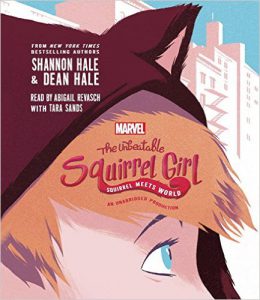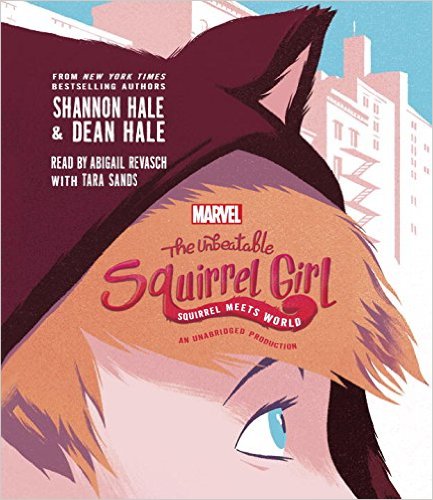Just when I was beginning to think The Unbeatable Squirrel Girl was simply a fantasy to entertain tweens in a Marvel Comics style, the book turned into a legitimately powerful tale (pun entirely intended!). With this Squirrel Meets World installment, the husband and wife team of Shannon Hale and Dean Hale cleverly pens a multi-genre adventure-mystery featuring superhero “Doreen Green, age fourteen. Over five feet tall and not an inch mean” (6), wh o is also “ with powers of squirrel and powers of girl” (259).
o is also “ with powers of squirrel and powers of girl” (259).
Despite her super hero abilities, Doreen has realistic and adolescent relatable life-dilemmas—she has body image issues and friendship challenges at Union Junior High School in Shady Oaks, New Jersey. Doreen eventually befriends Ana Sofía, a girl with hearing challenges who also has been pushed to the social margins by the “Somebodies,” the in-crowd who acknowledge some of their peers and snub others. Bullying actions like these don’t set well with Doreen, a “fireball of optimism” who is “nuts for justice.”
Ana and Doreen form an alliance with Tippy-Toe and her tree squirrel clan to solve the mystery of the Jersey Ghost and to discover why crime is increasing in Shady Oaks. As the sleuths collect clues left by their mysterious foe, they discover that super villain MM is terrorizing squirrels with metal traps and by inciting dogs to violence with ladybug-sized buttons that emit a high-pitched buzzing. Not until the novel’s end do readers discover MM’s identity and motivation and the depth of this super villain’s evil.
On their mission to challenge negativity, Ana and Doreen learn various lessons along the way, teaching the reader that:
- Humans often fear what they do not understand.
- We all have superpowers, talents that we deploy under stressful situations or talents that we take for granted.
- Computers are not programmed for deduction and extrapolation; we need humans to perform that kind of inferential thinking.
- The internet is not only hard to control, but it can take ideas planted by bullies and grow “an entire garden of mockery and ridicule” (241).
- “You don’t need anyone to tell you you’re great for it to be true” (306).
- Showing off a true talent is “totes permitted.”
The girls also make friends and recruit Squirrel Scouts, many of whom come from the LARPers, young people like Vin Tang who engage in Live Action Role Play.
Beneath the obvious conflicts and character traits in this book peppered with footnotes for the non-linear reader and featuring text messages and audio transcripts for the tech-savvy reader, a critical reader will discover deeper meaning. For example, from the ground squirrels and the tree squirrels who unite against a common enemy, we can all learn the value and power in unity. Then, from the squirrel-slang and colloquialisms, we recognize how language can separate and alienate us unless we are willing to reach across cultural lines to communicate.
Furthermore, with their character Ana Sofía, the Hales teach readers–by using blanks to indicate unheard bits of conversation and by exposing the stereotyping that Ana endures–what it might feel like to experience hearing challenges. Although hearing people often assume that lip reading is a way to eavesdrop on conversations from a distance, “only thirty percent of speech sounds are visible on the lips” (51), and much of lip reading depends on facial expressions and body language. In this way, the Hales not only perform some important myth-busting but make readers aware that ableist language (like saying something is lame) is hurtful because it devalues people who face physical or mental challenges. From Ana and her encounters, I am reminded not only of the lie in the schoolyard taunt about words being innocuous but that the power of words lies in how they’re received. I also receive reinforcement for my commitment to social justice, especially as it is affirmed in the Squirrel Scout Creed on page 186.
With all of these layers of meaning, the book proves its power. It inspires readers by providing models of characters who cope with adversity, discover their strengths, and use them for good.
- Posted by Donna

